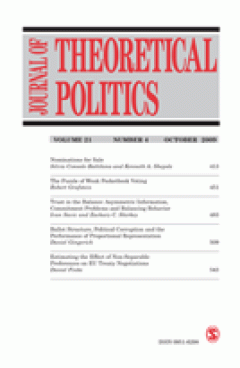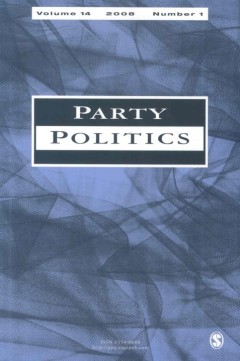Filter by

Ideology and Existence of 50%-Majority Equilibria in Multidimensional Spatial…
When aggregating individual preferences through the majority rule in an n-dimensional spatial voting model, the ‘worst-case’ scenario is a social choice configuration where no political equilibrium exists unless a super-majority rate as high as 1 — 1/(n+1) is adopted. In this paper we assume that a lower d-dimensional (d < n) linear map spans the possible candidates’ platforms. These d ‘ideolog…
- Edition
- Vol. 22 no. 4, October 2010.pp. 431-444
- ISBN/ISSN
- 09516298
- Collation
- -
- Series Title
- Journal of Theoretical Politics
- Call Number
- -

Power Concentration and Interstate Conflict: Is There a Connection?
Singer et al. (1972) hypothesized that the distribution of military—industrial capabilities among the major powers, as reflected in an index referred to as CON, would have an impact on the incidence of war for those states. Subsequent research on the possible connection between CON and interstate conflict has continued for almost four decades. A recent book declares that CON is the single most …
- Edition
- Vol. 22 no. 4, October 2010,pp. 407-429
- ISBN/ISSN
- 09516298
- Collation
- -
- Series Title
- Journal of Theoretical Politics
- Call Number
- -

The Inevitable Two-State Solution
By 2033, two states, Israel and Palestine, will be living side-by-side in an uneasy peace, with the risk of war between them and terrorism across their common border diminishing year by year. This two-state solution will not be imposed by the United States or the Arab world. It will be freely chosen by the Israelis and Palestinians themselves. The growing Palestinian majority living between the…
- Edition
- Vol. 25, No. 3, Fall 2008. Page 59–67
- ISBN/ISSN
- 0740-2775
- Collation
- -
- Series Title
- World Policy Journal
- Call Number
- -

Dominant party systems and electoral volatility in Africa: a comment on mozaf…
In a recent publication in this journal, Mozaffar and Scarritt claim to have found a puzzling combination of low fragmentation and high volatility in African party systems. However, if we look at national party systems rather than Africa-wide averages, include regime type as a variable and specify dominance, we find three different constellations: dominant party systems with relatively low …
- Edition
- Vol. 14, No. 1, January 2008. Page 113-130
- ISBN/ISSN
- 13540688
- Collation
- -
- Series Title
- Party Politics
- Call Number
- -

Intra-party politics and coalition formation: evidence from Swedish local gov…
Traditional theories about government formation in parliamentary democracies are based on the assumption that parties can be characterized as unitary actors. Many authors have questioned the soundness of this assumption. The problem with keeping it is that we may miss important factors explaining why certain coalitions form if we do not consider the role of intra-party politics. In this a…
- Edition
- Vol. 14, No. 1, January 2008. Page 71-89
- ISBN/ISSN
- 13540688
- Collation
- -
- Series Title
- Party Politics
- Call Number
- -

Equal access, unequal success major and minor Canadian parties on the net
The Internet has been heralded as the most revolutionary technology since the printing press. Within political science, much work centres around the democratizing potential of the Internet. Cyber-optimists argue that the Internet has the capacity to equalize political competition for parties. Other scholars argue that the Internet will not dramatically change the status of minor parties. …
- Edition
- Vol. 14, No. 1, January 2008. Page 51-70
- ISBN/ISSN
- 1354-0688
- Collation
- -
- Series Title
- Party Politics
- Call Number
- -

Rational Expectations or Heuristics?: Strategic Voting in Proportional Repres…
The process of information of electoral expectations in proportional representation systems is analysed in this article. Contrary to Duvergerian or electoral coordination theories, by using survey and in-depth elite intervieew data from Spain in the 1970s and 1980s, it is show that strategic voting depends on heuritics rather than on rational expectations. The main implication is taht strategic…
- Edition
- Vol. 14, No. 1, January 2008. Page 31-49
- ISBN/ISSN
- 1354-0688
- Collation
- -
- Series Title
- Party Politics
- Call Number
- -

The Politics of Institutional Change: Electoral Reform in Latin America, 1978…
Building on the growing body of research on political institutions, this article explores the causes of electoral reform, with specific reference to Latin America. What factors account for the extensive array of electoral reforms adopted in the region since the return to democracy? How are shifting patterns of political representation related to institutional change? In addressing these q…
- Edition
- Vol. 14, No. 1, January 2008. Page 5-30
- ISBN/ISSN
- 1354-0688
- Collation
- -
- Series Title
- Party Politics
- Call Number
- -

Fluid party systems, electoral rules and accountability of legislators in eme…
Does the system of repeated parliamentary elections function as a mechanism of political control in new democracies with fluid party systems? Moreover, does electoral format affect the degree to which voters are able to hold legislators accountable for their performance in office? In addressing these questions, we use a new database on all legislative incumbents and all parliamentary elections …
- Edition
- Vol. 14, No. 1, January 2008. Page 91-112
- ISBN/ISSN
- 13540688
- Collation
- -
- Series Title
- Party Politics
- Call Number
- -

Online Electoral Competition in Different Settings: A Comparative Meta-Analys…
This article takes a close look at two important theories concerning the effects that online party campaigning has on party competition. The equalization and normalization theories are tested for systematic logical dependence on conditions present in existing studies within the research field. The conditions are country-specific contextual settings and studyspecific methodology. The method of q…
- Edition
- Vol. 14, No. 2, March 2008. Page 223-244
- ISBN/ISSN
- 13540688
- Collation
- -
- Series Title
- Party Politics
- Call Number
- -

The Effective Number of Parties At Four Scales: Votes, Seats, Legislative Pow…
Different scholars count `the number of parties' in different ways, partly because they examine different parts of the political process and for different reasons. Sartori's qualitative approach focused mainly on competition for government, but is now largely supplanted by the quantitative `effective number of parties' index, which deals with votes and seats. But some quantitative research re…
- Edition
- Vol. 14, No. 2, March 2008. Page 167-187
- ISBN/ISSN
- 1354-0688
- Collation
- -
- Series Title
- Party Politics
- Call Number
- -

Party Polarization and Citizens' Left—Right Orientations
The article investigates the differences among West European countries in terms of the degree to which individuals' left—right self-placement is anchored in social, value and partisan factors. The study shows that clarity of party alternatives is much more important than political socialization in structuring citizens' left—right attitudes, i.e. the greater the clarity of party alternatives,…
- Edition
- Vol. 14, No. 2, March 2008. Page 189-209
- ISBN/ISSN
- 1354-0688
- Collation
- -
- Series Title
- Party Politics
- Call Number
- -

The Parameters of Party Systems
Despite the scepticism that increasingly surrounds their role and standing in contemporary democracies, scholarly interest in political parties continues unabated. But this interest is also proving uneven, with relatively little attention now being given to the study of party systems. More specifically, the level of theoretical interest in party systems remains limited, with almost no substanti…
- Edition
- Vol. 14, No. 2, March 2008. Page 147-166
- ISBN/ISSN
- 13540688
- Collation
- -
- Series Title
- Party Politics
- Call Number
- -

Recognition Rules, Party Labels and the Number of Parties in India: A Researc…
This Research Note offers an alternative explanation for the variation over time in the number of parties in India's national party system. It is argued that the actual number of parties has changed in direct response to the incentives provided by the official rules and regulations on party recognition. In turn, the raw number of parties has shaped the effective number of parties positively: t…
- Edition
- Vol. 14, No. 2, March 2008. Page 211-222
- ISBN/ISSN
- 13540688
- Collation
- -
- Series Title
- Party Politics
- Call Number
- -

Factions, Parties and the Durability of Parliaments, Coalitions and Cabinets:…
Did Thailand's multiple parties and factions influence cabinet and coalition durability in the period 1979 to 2001? If so, which one — parties or factions — was the more significant? Taking a Transaction Costs Analysis approach, this article addresses these questions and argues that intra-party factions, as the building blocks of Thai parliamentary politics, have been more important than…
- Edition
- Vol. 14, No. 3, March 2008. Page 299-323
- ISBN/ISSN
- 1354-0688
- Collation
- -
- Series Title
- Party Politics
- Call Number
- -

The Christian Democratic Phoenix and Modern Unsecular Politics
Christian democracy is still posing theoretical problems of definition and empirical puzzles of classification and interpretation. Analyses based on secularization theory produce puzzles and anomalies and have little to offer as explanations for the variation in Christian democratic power mobilization. Empirically, this article focuses on Christian democracy in The Netherlands and offers an exp…
- Edition
- Vol. 14, No. 3, May 2008. Page 259-279
- ISBN/ISSN
- 1354-0688
- Collation
- -
- Series Title
- Party Politics
- Call Number
- -

Factors Influencing the Decision of the Young Politically Engaged To Join a P…
Situated in the literature concerning the decline of party members, and the dearth of young party members, this article considers the factors that influence the decision of a politically engaged young person to join, or not join, a political party. Making use of a unique dataset, we examine the attitudes and socialization of a large group of politically active young Canadians, a group that incl…
- Edition
- Vol. 14, No. 3, May 2008. Page 345-369
- ISBN/ISSN
- 13540688
- Collation
- -
- Series Title
- Party Politics
- Call Number
- -

The Political Representation of Ethnic Minorities: Denmark as a Deviant Case
In general, ethnic minorities are strongly under-represented in representative bodies; however, there is no rule without exceptions. In the municipal elections in Denmark in 2001, the number of ethnic minorities who won election to the local councils throughout the country almost corresponded to their percentage in the general population. The explanation for this can be found in the Danis…
- Edition
- Vol. 14, No. 3, May 2008. Page 325-343
- ISBN/ISSN
- 13540688
- Collation
- -
- Series Title
- Party Politics
- Call Number
- -

Parties and Leader Effects: Impact of Leaders in the Vote for Different Types…
In this article, I analyse whether the electorate of different party types attributes different degrees of importance to leaders, as suggested by a recent party typology. Based on expert advice, 15 parties in six democracies were assigned to the following party types: class-mass, denominational and catch-all. Individual level data are used to determine the relative importance of leader ef…
- Edition
- Vol. 14, No. 3, May 2008. Page 281-298
- ISBN/ISSN
- 1354-0688
- Collation
- -
- Series Title
- Party Politics
- Call Number
- -

Centre-Right Parties and Political Outcomes in East Central Europe
The emergence of moderate centre—right parties in East Central Europe after 1989 was closely related to the strength and nature of organized opposition during the late communist period. Where such opposition was strong enough to take power, it went on to become the ideological, organizational and elite base for one or more moderate right parties. Where it was weak, moderate right parties were…
- Edition
- Vol. 14, No. 4, July 2008. Page 387-405
- ISBN/ISSN
- 13540688
- Collation
- -
- Series Title
- Party Politics
- Call Number
- -
 Computer Science, Information & General Works
Computer Science, Information & General Works  Philosophy & Psychology
Philosophy & Psychology  Religion
Religion  Social Sciences
Social Sciences  Language
Language  Pure Science
Pure Science  Applied Sciences
Applied Sciences  Art & Recreation
Art & Recreation  Literature
Literature  History & Geography
History & Geography